| Solar eclipse of October 2, 1978 | |
|---|---|
 Map | |
| Type of eclipse | |
| Nature | Partial |
| Gamma | 1.1616 |
| Magnitude | 0.6905 |
| Maximum eclipse | |
| Coordinates | 72°00′N 159°36′E / 72°N 159.6°E |
| Times (UTC) | |
| Greatest eclipse | 6:28:43 |
| References | |
| Saros | 153 (7 of 70) |
| Catalog # (SE5000) | 9461 |
A partial solar eclipse occurred at the Moon's ascending node of the orbit on Monday, October 2, 1978. A solar eclipse occurs when the Moon passes between Earth and the Sun, thereby totally or partly obscuring the image of the Sun for a viewer on Earth. A partial solar eclipse occurs in the polar regions of the Earth when the center of the Moon's shadow misses the Earth. The eclipse is a part of the 153 saros cycle. Its the 7th eclipse of the saros cycle. The solar eclipse was visible in most of Asia Except northern Asia, Northeastern Europe, tiny northern part of Oceania, and tiny parts of Guam and other American islands
Related eclipses
Eclipses in 1978
- A total lunar eclipse on Friday, 24 March 1978.
- A partial solar eclipse on Friday, 7 April 1978.
- A total lunar eclipse on Saturday, 16 September 1978.
- A partial solar eclipse on Monday, 2 October 1978.
Solar eclipses of 1975–1978
There were 8 solar eclipses (at 6 month intervals) between May 11, 1975 and October 2, 1978.
| Solar eclipse series sets from 1975–1978 | ||||||
|---|---|---|---|---|---|---|
| Descending node | Ascending node | |||||
| Saros | Map | Gamma | Saros | Map | Gamma | |
| 118 |  1975 May 11 Partial | 1.06472 | 123 | 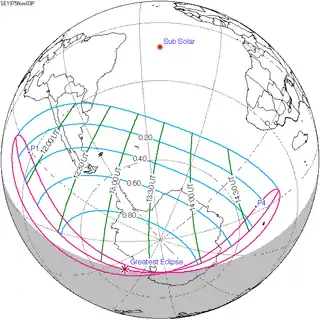 1975 November 3 Partial | −1.02475 | |
| 128 |  1976 April 29 Annular | 0.33783 | 133 | 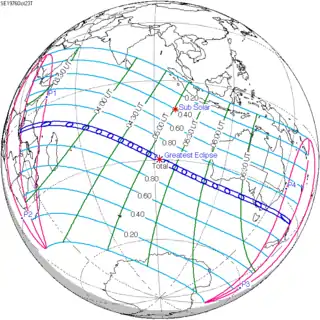 1976 October 23 Total | −0.32699 | |
| 138 |  1977 April 18 Annular | −0.39903 | 143 |  1977 October 12 Total | 0.38363 | |
| 148 |  1978 April 7 Partial | −1.10812 | 153 |  1978 October 2 Partial | 1.16164 | |
Metonic series
The metonic series repeats eclipses every 19 years (6939.69 days), lasting about 5 cycles. Eclipses occur in nearly the same calendar date. In addition, the octon subseries repeats 1/5 of that or every 3.8 years (1387.94 days).
| 22 eclipse events between December 13, 1898 and July 20, 1982 | ||||
|---|---|---|---|---|
| December 13–14 | October 1–2 | July 20–21 | May 9 | February 24–25 |
| 111 | 113 | 115 | 117 | 119 |
 December 13, 1898 |
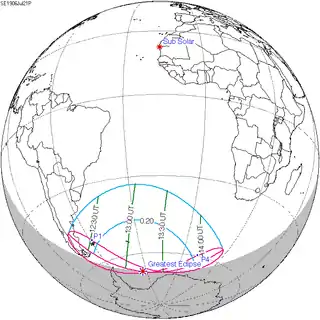 July 21, 1906 |
 May 9, 1910 |
 February 25, 1914 | |
| 121 | 123 | 125 | 127 | 129 |
 December 14, 1917 |
 October 1, 1921 |
 July 20, 1925 |
 May 9, 1929 |
 February 24, 1933 |
| 131 | 133 | 135 | 137 | 139 |
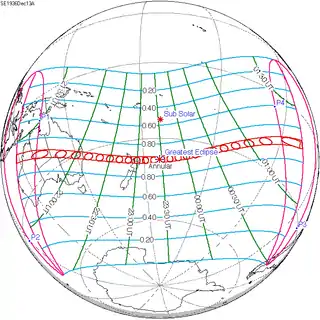 December 13, 1936 |
 October 1, 1940 |
 July 20, 1944 |
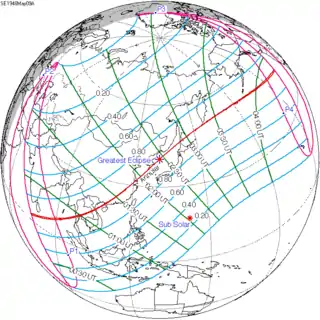 May 9, 1948 |
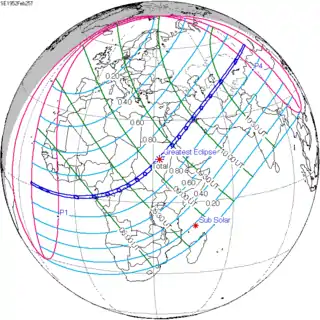 February 25, 1952 |
| 141 | 143 | 145 | 147 | 149 |
 December 14, 1955 |
 October 2, 1959 |
 July 20, 1963 |
 May 9, 1967 |
 February 25, 1971 |
| 151 | 153 | 155 | ||
 December 13, 1974 |
 October 2, 1978 |
 July 20, 1982 | ||
References
External links
- Earth visibility chart and eclipse statistics Eclipse Predictions by Fred Espenak, NASA/GSFC
.jpg.webp)

